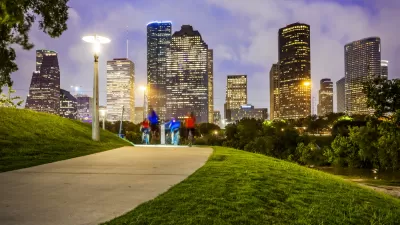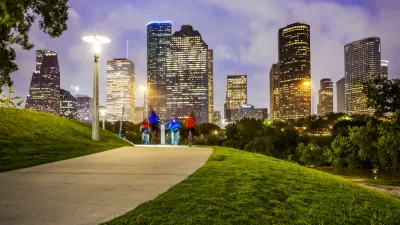Building on 2009's Transit Corridor Ordinance, Houston's Walkable Places Committee is creating a process for specific neighborhoods to adopt new rules emphasizing walkability.

Earlier this year, a Kinder Institute survey found rising support for a walkable lifestyle in Houston. Also writing for the Kinder Institute, Hilary Ybarra discusses a new initiative to rework building codes on a place-by-place basis to encourage walkability.
While Houston at large isn't very walkable, specific sections can be made more so. "Manhattan and San Francisco are walkable, but so is a thriving small town Main Street, activated by lively street fronts and safe sidewalks, easily accessible from residential neighborhoods."
Ybarra discusses the 2009 Transit Corridor Ordinance, which incentivized pedestrian-friendly construction. The recently established Walkable Places Committee takes a different approach. The committee "is currently focused on creating an application-based process to establish specific 'walkable place' areas. Under this new system, any neighborhood could voluntarily apply to become a 'walkable place' and in doing so establish their own set of self-defined unique rules for development to encourage walkability."
"But once adopted, unlike the Transit Corridor Ordinance, neighborhood- and site-specific building rules would be required, not optional, for all new development." The current target is to adopt a new ordinance in 2019. The trick, Ybarra notes, is to connect pockets of walkability on a citywide scale.
FULL STORY: HOW CAN WE MAKE SPRAWLING HOUSTON FEEL URBAN AND WALKABLE?

Study: Maui’s Plan to Convert Vacation Rentals to Long-Term Housing Could Cause Nearly $1 Billion Economic Loss
The plan would reduce visitor accommodation by 25,% resulting in 1,900 jobs lost.

North Texas Transit Leaders Tout Benefits of TOD for Growing Region
At a summit focused on transit-oriented development, policymakers discussed how North Texas’ expanded light rail system can serve as a tool for economic growth.

Why Should We Subsidize Public Transportation?
Many public transit agencies face financial stress due to rising costs, declining fare revenue, and declining subsidies. Transit advocates must provide a strong business case for increasing public transit funding.

How to Make US Trains Faster
Changes to boarding platforms and a switch to electric trains could improve U.S. passenger rail service without the added cost of high-speed rail.

Columbia’s Revitalized ‘Loop’ Is a Hub for Local Entrepreneurs
A focus on small businesses is helping a commercial corridor in Columbia, Missouri thrive.

Invasive Insect Threatens Minnesota’s Ash Forests
The Emerald Ash Borer is a rapidly spreading invasive pest threatening Minnesota’s ash trees, and homeowners are encouraged to plant diverse replacement species, avoid moving ash firewood, and monitor for signs of infestation.
Urban Design for Planners 1: Software Tools
This six-course series explores essential urban design concepts using open source software and equips planners with the tools they need to participate fully in the urban design process.
Planning for Universal Design
Learn the tools for implementing Universal Design in planning regulations.
City of Santa Clarita
Ascent Environmental
Institute for Housing and Urban Development Studies (IHS)
City of Grandview
Harvard GSD Executive Education
Toledo-Lucas County Plan Commissions
Salt Lake City
NYU Wagner Graduate School of Public Service





























